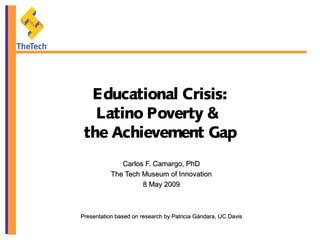
8May2009-PovertyEdCrisis-SVEF
- 1. Educational Crisis: Latino Poverty & the Achievement Gap Carlos F. Camargo, PhDCarlos F. Camargo, PhD The Tech Museum of InnovationThe Tech Museum of Innovation 8 May 20098 May 2009 Presentation based on research by Patricia GPresentation based on research by Patricia Gáándara, UC Davisndara, UC Davis
- 2. California’s Demographics • 48% of K-12 students are Latino • 52% of K-2 students are Latino • Around 2010, the majority of all California’s students will be Latino
- 3. Who are Latino Children? • They are largely, but not exclusively, of Mexican origin • 60% of Latinos are native born; 40% immigrants • Most immigrants are English learners, but most English learners are NOT immigrants. At least 2/3 of Latino EL students are born in the U.S.
- 4. Howare Latino students faring academically? Let’s look at the data…
- 5. Percent Kindergartners Scoring at Highest and Lowest Quartiles, Math & Reading, 1998 and 2000 Ethnic Group Highest Quartile Lowest Quartile Highest Quartile Lowest Quartile White 30 18 32 18 Asian 39 13 38 13 Black 15 34 10 39 Latino 15 42 14 40 Nat. Am 9 57 9 50 Source: West, Denton, Germino-Hausken, 2000, America’s Kindergartners, NCES
- 6. Percent Grade 4 Students Scoring Proficient + NAEP Reading and Math, By Ethnicity, 2005 Ethnicity Reading Math White 41 47 Asian 42 55 Black 13 13 Latino 16 19 Native Am 18 21
- 7. Percent Grade 8 Students Scoring Proficient + NAEP Reading & Math 2005, By Ethnicity Ethnicity Reading Math White 39 39 Asian 40 47 Black 12 9 Latino 15 13 Native Am 17 14
- 8. The Widening Gap: Percent of 25-29 year olds with BA or higher, by Ethnicity Ethnicity 1975 1985 1995 2000 2005 White 24 24 29 34 34 African American 11 12 15 18 18 Latino 9 11 9 10 11
- 9. Is This a Temporary ProblemDue to Immigration? • Each generation of Latinos is improving in schooling and income • But immigrants often out-perform native born • Progress stalled at 3rd generation • Proportionately fewer Latinos go to college than in 1976 • Drop out rates are extraordinarily high, even for native born Latinos--up to 50%
- 10. Is Language the Problem? • More than half of Latinos are English speakers, but as a group they perform very poorly • Learning English does not close the achievement gaps with White English speakers
- 11. Why Do Latinos Fare So Poorly? • No single predictor more powerful than parental education • Isolated by SES, language, and ethnicity in the poorest schools • Entering into a post-industrial economy--no upward mobility • Very weak social safety net • Huge increase in cost of college, decrease in financial aid
- 12. Poverty • U.S. has highest child poverty rates among wealthy nations; Latinos are the most poor • 28% of Latinos under 18 live in poverty in the U.S. (14% of White students) • One third (31%) of Latinos under 6 are poor • 73% of all Latino 4th graders qualify for free/reduced price lunch
- 13. Poverty in California • 27% of Latino children live in poverty • Three times the number of White children living in poverty • More than half of all poor children in California are Latino
- 14. Parent Education Level K-12 Students, 2003 Ethnicity Less than High School High School Bachelor’s degree or Higher White 4.3 95.7 39.0 Black 12.3 87.7 16.4 Latino 39.4 60.6 10.9
- 15. Mean SAT Score by Ethnicity and Income, 2004 <$35,000 >$70,000 Latino 857 1009 White 984 1076
- 16. What are the Consequences? • If California does not increase the college- going rate of Latinos: – It is projected to lo se 11% per capita income between 2000 and 2020 – This compares to a 30% incre ase in per capita income between 1980 and 2000 [NCHEMS]
- 17. What to do? • Address Latino poverty • Offer high quality preschool + interventions • Reduce isolation in school and neighborhoods • Stop immigrant harassment--all children are guaranteed schooling • Provide highly qualified, bilingual teachers • Fund the college education of Latino (and other poor) students
